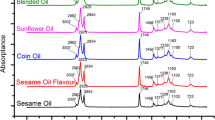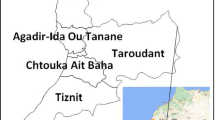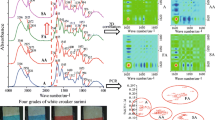Abstract
This investigation was aimed at developing a rapid analysis method for authentication of Chinese sesame oils by FTIR spectrometry and chemometrics. Ninety-five sesame oil samples were collected from the six main producing areas of China to include most if not all of the significant spectral variations likely to be encountered in future authentic materials. Two class modeling techniques, the soft independent modeling of class analogy (SIMCA) and the partial least squares class model (PLSCM) were investigated and the data preprocessing techniques including smoothing, derivative and standard normal variate (SNV) tests were performed to improve the classification performance. It was demonstrated that SIMCA and PLSCM can detect various adulterated sesame oils doped with 3% or more (w/w) of other cheaper oils, including rapeseed, soybean, palm and peanut oils. First derivative, second derivative and SNV tests significantly enhanced the class models by reducing baseline and background shifts. Smoothing of raw spectra led to inferior identification performance and proved itself to be unsuitable because some of the detailed frequency details were lost during smoothing. The best model performance was obtained with second derivative spectra by SIMCA (sensitivity 0.905 and specificity 0.944) and PLSCM (sensitivity 0.952 and specificity 0.937). Although it is difficult to perform an exhaustive sampling of all types of pure sesame oils and potential adulterations, PLS and SIMCA combined with FTIR spectrometry can detect most of current adulterations of sesame oils on the Chinese market.






Similar content being viewed by others
References
Tashiro T, Fukuda Y, Osawa T, Namiki M (1990) Oil and minor components of sesame (Sesamum indicum L.) strains. J Am Oil Chem Soc 67:508–511
Jyothi B, Ansari NA, Vijay Y, Anuradha G, Sarkar A, Sudhakar R, Siddiq EA (2011) Assessment of resistance to Fusarium wilt disease in sesame (Sesamum indicum L.) germplasm. Australasian Plant Pathol 40:471–475
Salunkhe DK, Chavan JK, Adsule RN, Kadam SS (1992) World oilseeds: chemistry technology and utilization. Van Nostrand Reinhold, New York
Jamieson GS, Baughman WF (1924) The chemical composition of sesame oil. J Am Chem Soc 46:775–778
Budowski P, Markley KS (1951) The chemical and physiological properties of sesame oil. Chem Rev 48:125–151
Abou-Gharbia HA, Shahidi F, Adel A, Shehata Y, Youssef MM (1997) Effects of processing on oxidative stability of sesame oil extracted from intact and dehulled seeds. J Am Oil Chem Soc 74:215–221
Arslan Ç, Uzun B, Ülger S, İlhan Çağırgan M (2007) Determination of oil content and fatty acid composition of sesame mutants suited for intensive management conditions. J Am Oil Chem Soc 84:917–920
Shahidi F, Amarowicz R, Abou-Gharbiaa HA, Adel A, Shehatab Y (1997) Endogenous antioxidants and stability of sesame oil as affected by processing and storage. J Am Oil Chem Soc 74:143–147
Uzun B, Arslan Ç, Furat Ş (2008) Variation in fatty acid compositions oil content and oil yield in a germplasm collection of sesame (Sesamum indicum L.). J Am Oil Chem Soc 85:1135–1142
Abou-Gharbia HA, Adel A, Shehata Y, Shahidi F (2000) Effect of processing on oxidative stability and lipid classes of sesame oil. Food Res Int 33:331–340
Were BA, Onkware AO, Gudu S, Welander M, Carlsson AS (2006) Seed oil content and fatty acid composition in East African sesame (Sesamum indicum L.) accessions evaluated over 3 years. Field Crop Res 97:254–260
Rangkadilok N, Pholphana N, Mahidol C, Wongyai W, Saengsooksree K, Nookabkaew S, Satayavivad J (2010) Variation of sesamin, sesamolin and tocopherols in sesame (Sesamum indicum L.) seeds and oil products in Thailand. Food Chem 122:724–730
Yen GC, Shyu SL (1989) Oxidative stability of sesame oil prepared from sesame seed with different roasting temperatures. Food Chem 31:215–224
Shimoda M, Shiratsuchi H, Nakada Y, Wu Y, Osajima Y (1996) Identification and sensory characterization of volatile flavor compounds in sesame seed oil. J Agric Food Chem 44:3909–3912
Vlachos A, Arvanitoyannis IS (2008) A review of rice authentication/adulteration methods and results. Crit Rev Food Sci 48:553–598
Alishahi A, Farahmand H, Prieto N, Cozzolino D (2010) Identification of transgenic foods using NIR spectroscopy: a review. Spectrochim Acta A Mol Biomol Spectrosc 75:1–7
Cen H, He Y (2007) Theory and application of near infrared reflectance spectroscopy in determination of food quality. Trends Food Sci Tech 18:72–83
Tzouros NE, Arvanitoyannis IS (2001) Agricultural produces: synopsis of employed quality control methods for the authentication of foods and for the classification of foods according to their variety of geographical origin. Crit Rev Food Sci 41:287–319
Karoui R, Downey G, Blecker C (2010) Mid-infrared spectroscopy coupled with chemometrics: a tool for the analysis of intact food systems and the exploration of their molecular structure-quality relationships—a review. Chem Rev 110:6144–6168
Wilson RH, Tapp HS (1999) Mid-infrared spectroscopy for food analysis: recent new applications and relevant developments in sample presentation methods. Trend Anal Chem 18:85–93
Arvanitoyannis IS, Vlachos A (2007) Implementation of physicochemical and sensory analysis in conjunction with multivariate analysis towards assessing olive oil authentication/adulteration. Crit Rev Food Sci 47:441–498
Forina M, Oliveri P, Lanteri S, Casale M (2008) Class-modeling techniques, classic and new, for old and new problems. Chemom Intell Lab Syst 93:132–148
Brereton RG (2011) One-class classifiers. J Chemom 25:225–246
De Maesschalck R, Candolfi A, Massart DL, Heuerding S (1999) Decision criteria for soft independent modelling of class analogy applied to near infrared data. Chemom Intell Lab Syst 47:65–77
Xu L, Fu HY, Jiang N, Yu XP (2010) A new class model based on partial least square regression and its applications for identifying authenticity of bezoar samples. Chin J Anal Chem 38:175–180
Savitzky A, Golay MJE (1964) Smoothing and differentiation of data by simplified least-squares procedures. Anal Chem 36:1627–1639
Barnes RJ, Dhanoa MS, Lister SJ (1989) Standard normal variate transformation and detrending of near infrared diffuse reflectance. Appl Spectrosc 43:772–777
Tang B, Wu CFJ (1997) A method for constructing super-saturated designs and its Es2 optimality. Can J Stat 25:191–201
Stanimirova I, Walczak B, Massart DL, Simeonov VA (2004) Comparison between two robust PCA algorithms. Chemom Intell Lab Syst 71:83–95
Hubert M, Rousseeuw PJ, Verboven SA (2002) Fast method for robust principal components with applications to chemometrics. Chemom Intell Lab Syst 60:101–111
Snee RD (1977) Validation of regression models, methods and examples. Technometrics 19:415–428
Mirghani MES, Che Man YB, Jinap S, Baharin BS, Bakar J (2003) Application of FTIR spectroscopy in determining sesamol in sesame seed oil. J Am Oil Chem Soc 80:1–4
Xu QS, Liang YZ (2001) Monte Carlo cross validation. Chemom Intell Lab Syst 56:1–11
Haaland DM, Thomas EV (1988) Partial least-squares methods for spectral analyses. 1. relation to other quantitative calibration methods and the extraction of qualitative information. Anal Chem 60:1193–1202
Haaland DM, Thomas EV (1988) Partial least-squares methods for spectral analyses. 2. application to simulated and glass spectral data. Anal Chem 60:1202–1208
Kokalj M, Rihtarič M, Kreft S (2011) Commonly applied smoothing of IR spectra showed unappropriate for the identification of plant leaf samples. Chemom Intell Lab Syst 108:154–161
Acknowledgments
This work was financially supported by the National Public Welfare Industry Projects of China (no.201210010), Hangzhou Programs for Agricultural Science and Technology Development (no.20101032B28) and the Key Scientific and Technological Innovation Team Program of Zhejiang Province (no.2010R50028). Dr. Chen-Bo Cai is grateful to the financial aid of the Applied and Basic Research Project of Yunan Provincial Science and Technology Department (no.2010CD087).
Author information
Authors and Affiliations
Corresponding authors
About this article
Cite this article
Deng, DH., Xu, L., Ye, ZH. et al. FTIR Spectroscopy and Chemometric Class Modeling Techniques for Authentication of Chinese Sesame Oil. J Am Oil Chem Soc 89, 1003–1009 (2012). https://doi.org/10.1007/s11746-011-2004-8
Received:
Revised:
Accepted:
Published:
Issue Date:
DOI: https://doi.org/10.1007/s11746-011-2004-8




